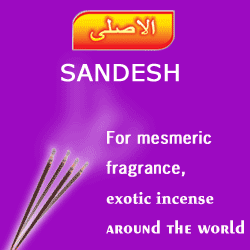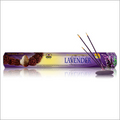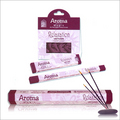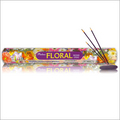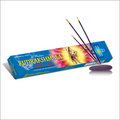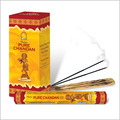FAQs on Incense & Incense Products
1.Does incense stick contain chemicals?
No, under industrial norms for manufacturing technique, incense sticks are made of only aromatic biotic materials, which release fragrant smoke when burned. No chemicals are used. Fragrance oil, essential oil and base oil are the major components of incense sticks.
2.How the use of incense sticks originated?
The use of incense may have originated in Ancient Egypt, where the gum resins and oleo gum resins of aromatic trees were imported from the Arabian and Somali coasts to be used in religious ceremonies.
3.What are the different types of incense sticks?
Dipped Incense Sticks, Hand Rolled Incense Stick, Smudge Sticks, Cones, Japanese Incense (Koh), Loose Incense Powders, Resins, Woods, Incense Mixture, these are the different forms of incense sticks available in the market.
4.How incense helps in aromatherapy?
Aromatherapy is a treatment that uses the power of different incense for curing problems like stress, frustration, anxiety etc. In aroma therapy a variety of incense of essential oil and sticks are used in. These incense tigers the neurons of our head and helps in calming.
5.What are the different health and psychological problems that can be cured by incense?
Specific incense is capable of curing specific problems. In the market various types of incense, in the form of sticks or essential oil, can be found. There are various articles written on the properties and uses of these incense; those can be preferred, example " < Give the link of 2 articles>" Moreover, an professional aroma therapist is to be consulted regarding this point. Depending on your requirement, he will suggest u the best suited incense and also the quantity to be used upon.
6.For what purposes incense sticks can be used?
After inflaming incense sticks we get a clean-smelling, hygiene, sweetened air rooms and bathrooms. Then incense sticks aromas are used in religious and public ceremonies. They are also believed to have romance-inspiring aromas.
7. How essential oil should be used?
It can be added to the bath water, but only few drops. Then, essential oil can be added to the messaging oil to get the maximum benefits. Even if a bottle of essential oil is kept in the room, it keeps the room scented.
8.How to chose the right incense sticks?
We get the benefits of the fragrance sticks through the fumes coming out from the sticks; we inhale these fumes. So it is very important that we use high quality incense sticks. It is good to go for renowned and widely used brands. The market is full of substandard and cheap incense sticks. It is always recommended to pay a bit more but to get high quality incense sticks.
9.Is using essential oil is harmful for children?
High Doses of essential oil should never be used on children. It's not that essential oil are not to be used on children but in very diluted form and only after consulting a aroma therapist. One shouldn't try this without consulting anyone.
10.Can we make incense sticks at home?
Though incense stick making is a cottage industry business only, when people manufacture these incense sticks in there houses only, but still various tools and raw materials are required. Arranging these raw materials and tools for a very small scale production will not be economical.
11.How incense sticks are useful during Yoga?
Yoga can be performed only in a very quite and calm environment, where there is peace. The right time and place for yoga is morning hours and a quite room where enough of sunlight and air can enter. In addition to these, incense sticks can further build the mood through its fragrance. The scent of these sticks calm down our excitement, also triggers the neurons and cells of our brain and we feel elevated and fresh.
12.What are the ingredients used in incense sticks?
Incense sticks are made of fragrant oils collected from the extracts of herbal plants, resins, as well as some flowers, seeds, roots, and barks that are aromatic. Even animal extract are used in incense sticks; the very famous musk incense sticks are manufactured using the musk of deers.
14.Are incense sticks and scented candles the same thing?
Both of them serve the same purpose, but ingredient wise they are different. Scented candles are made of wax and fragrance oil. Moreover, scented candles are more attractive and expensive than incense sticks
15.How incense sticks are manufactured?
For the commercial production of incense sticks, mostly three ways are practiced; these are Hand roll production, Machine deep production and Pressed technique.
16.How does incense give fragrance?
Incense sticks are made of aromatic resins that are volatile. When we burn the sticks, the aromatic volatile compounds vaporize on receiving their volatizing temperature. These vapors quickly dissolve in the air and spreads out simultaneously giving fragrance.
17.Are there any harmful by products during incense manufacturing?
There are no byproducts. Dust is the primary waste material and is contained by vacuuming and excellent ventilation.
18. What are the different types of Indian Incense?
Indian incense can be categorized as Masala incenses and charcoal incense. Masala incense are made by blending several solid scented ingredients into a paste and then rolling that paste onto a bamboo core stick. Charcoal incenses are made by dipping an unscented non-perfume stick into a mixture of perfumes and/or essential oils. Most charcoal incenses are black in color.
19. How safe incense sticks are for health?
In spite of having so many benefits, there is no doubt that incense smoke contains various contaminants such as carbon monoxide (CO), nitrogen oxides (NOx), sulfur oxides (SOx), volatile organic compounds (VOCs) and absorbed toxic pollutants (polycyclic aromatic hydrocarbons and toxic metals). These contaminants are carcinogenic and can cause respiratory diseases. But these risks can be avoided if incense sticks are burnt in a well ventilated room.
20.Which is the safest type of incense sticks?
It is difficult to exactly say which is the safest, yet researches have shown that the emission rate of contaminants decreases in the row Indian sandalwood > Japanese aloeswood > Taiwanese aloeswood > smokeless sandalwood.
|


